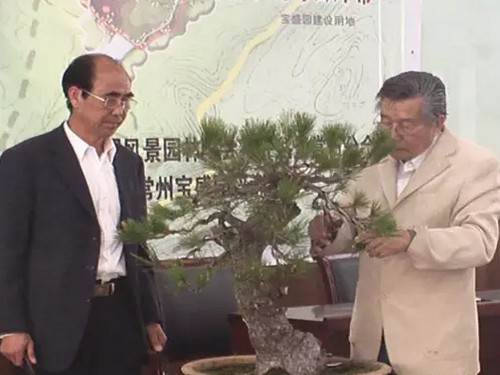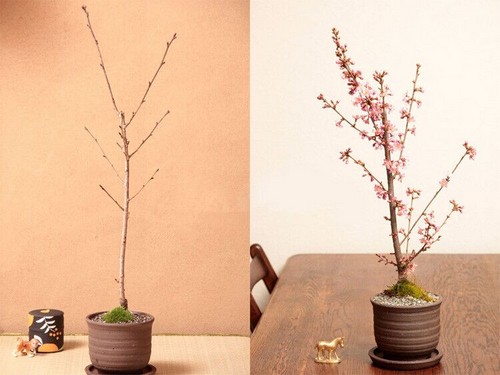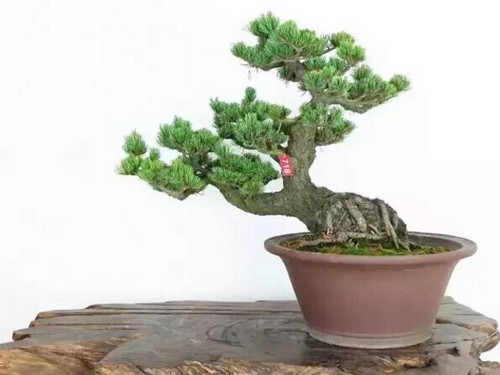Technical guide for modeling of pine bonsai
Every creature in nature is affected by other creatures, and people interfere with the growth of pine trees through technical means, which is a manifestation of this effect. To this day, this phenomenon still exists, which is the prevalence of potted plants. Pine has a good meaning in Chinese traditional culture, symbolizing the character of perseverance, longevity and so on, so it is deeply loved by people. Because of this, pine bonsai is also favored by people. A quaint flowerpot with a small pine tree and a few chic stones next to it is placed in the spacious living room, which really improves the taste of the host.

A poor and excellent pine bonsai should have beautiful shape and superb maintenance and management technology, both of which are indispensable. Even if the bonsai master modeling production, if not careful maintenance and management, there will be withered or prosperous phenomenon, so that the original bonsai beyond recognition. A pot of pine embryo pile can be completed in a very short time in the hands of bonsai technicians, but years of hard work and superb management skills are needed to maintain and manage well.
I. the complete process of bonsai modeling
1. A foundation-the comprehensive quality of culture and art and the technical basis of bonsai production.
2. Four stages:
① creation preparation: potted materials and tools, soil, pots, etc.
② idea: from creative motivation to the birth of the image of the complete work in the future. The idea is based on the principle of "taking measures in accordance with their aptitude". Looking for the "viewing surface", it should be noted that the requirement of the viewing surface is from the root plate to the top of the trunk, and its stretching posture and development trend can play a decisive role. The second is the left and right branches. For example, when creating, we should pay attention to the trunk to tuck in the abdomen, so as to form a space before the formation, and a depth at the back: the stem tip tilts forward to form a cordial and harmonious meaning.
③ processing and production: Zunshun series bonsai art expression, gardening technical measures such as hanging, pruning, carving and chiseling to complete the specific processing and production procedures. First the trunk and then the branches, the shape of the branches should be from the bottom up, and finally on the basin.
④ maintenance and improvement: conservation is the continuation of bonsai modeling of trees, is the stage of improvement. Bonsai is a living work of art that can never be completed.
Second, the creative characteristics of pine bonsai
1. Pine bonsai should be created with magnificent and masculine beauty.
2. According to the ecological and physiological characteristics of pine, it is determined that it can only use the original branches for hanging modeling, in order to reflect the natural posture of overlapping branches.
3. Pine trees are sun-loving and drought-tolerant, so it is appropriate to choose soil with good drainage and ventilation and purple sand shallow mouth basin.
Third, the transplanting modeling time of pine bonsai materials
The best time for transplanting pine bonsai materials is from August to early September and from January to early February in the lunar calendar.
The best time for pine bonsai modeling is from December to early February of the lunar calendar.
4. Roots, stems and branches are the skeleton structures of bonsai trees.
Modeling means that the skeleton structure of the root, stem and branch of the material is recombined according to the artistic law of bonsai beauty, so as to make it a living bonsai art work with complete coordination, smooth lines and far-reaching artistic conception.
The main contents of the reorganization are: trade-off, adjustment and correction.
1. Backbone processing
The posture of trees in nature is ever-changing, mostly because the growth environment of trees is different, which leads to different changes in the posture of the trunk, so the treatment of trunk is the key to the modeling of bonsai trees. Although there are many kinds of tree trunk in nature, to sum up, there are only two basic forms: straight trunk and curved trunk. Qu Gan can be the deformation treatment of "S" shape, and can be divided into several bonsai forms, such as oblique dry type, qu dry type, cliff type and so on.
Requirements for the trunk of trees:
Regardless of whether the ① is curved or straight, it requires the trunk to shrink gradually from the bottom up. The speed of change is fast, it can make short and strong bonsai, and the speed of change is slow, it can be made into "literati tree" bonsai.
② requires natural stretching and proper bending of the trunk lines in addition to being straight.
If ③ is a multi-dry material, we should not only pay attention to the above two points, but also pay attention to the changes in the size of the trunk, primary and secondary, and density.
How to deal with the backbone:
① truncation: tree bonsai material, independent trunk base to tip are constantly changing, such as the thickness of the trunk, straight, the position of the branches in the trunk, bark texture color, etc., where think that the upper part of the trunk is lack of change or ordinary performance, cut off; if you think that the height of the retained section is not enough, for perfect coordination, when standing the highest position of the branch to replace the top tip.
② uses simple machines to correct the trunk stretching posture, making it IN and shorter or making the trunk lines more vigorous and vivid. Curvature and straightness are all talents, and it is possible for the trunk lines to meet the requirements of bonsai beauty and give full play to its characteristics.
③ small bonsai backbone shape, generally to be properly bent, in order to reflect the vitality of the song.
2. Branch treatment
Branch treatment, the most concentrated embodiment of the bonsai modeling of the trade-off, adjustment, correction of the specific content.
(1) the choice of branches: the most concerned issues are the elimination of branches, the ideal position of the first branch in the trunk, the length of branches, the density of branches, the change of branches, the composition of the crown, the description of the outer profile of the crown, and so on.
According to the general rule, the diameter of the branch should be about 1x4 of the diameter of the main stem of the branch. In a straight picture work, the length of the branch should be much shorter than the height of the main thousand; in the work of the banner picture, the length of the branch may exceed the height of the trunk.
The first branch should be at the height of the trunk 1 up and down 3 or 2 up and down 3. The branches of pine bonsai should be slightly higher to reflect the tall and straight style, but it is not suitable to branch at the height of the trunk.
The distance between the first branch and its upper branch is the largest to highlight the main branch. The more upward the development, the closer the distance between the branches, so as to make the crown plump, and pay attention to prevent the phenomenon of "showing neck". The choice and control of branches should be strict in the lower part and lenient in the upper part.
The first branch is the longest branch of the whole tree, which develops upward in turn, and should be gradually thinned and shortened. To form a crown as an unequilateral triangle. With regard to the overall treatment of branches, there are changes in front and back, length and density, so that the actual outer line of the crown should be a free curve with ups and downs, in and out, rhythm and light sense of music.
The branches that should be avoided in the modeling process are generally whorled branches, symmetrical branches, erect branches, inward branches, close parallel branches, cross branches, front branches, front branches, back branches, cut dry branches and so on. One way to deal with these branches is to adjust their extension direction, and the other is to delete them directly.
(2) the direction of branch growth was adjusted. There are up and down adjustments and front and back adjustments.
The growth direction of tree branches in nature varies with tree species, tree age and growth environment, which can be summed up in the following different forms: upward extension type, flat type, sagging type and radial type.
The branches of pine and cypress bonsai should be spread and drooped, and the spreading or drooping angle of the branches is generally between 45 °and 90 °. The angle between the branches and the trunk of the same tree is generally the same and should not be changed at will. For miscellaneous trees, it varies from tree to tree, so it can be relaxed appropriately and "miscellaneous" is allowed.
Before and after the branch adjustment has a range, generally only in a plane to make a small angle adjustment, so that the branch has a natural stretch, simple and generous beauty.
(3) Correction of branch stretching posture
"combining strength with softness" is the basic requirement for the stretching posture of a tree branch, which refers to the posture change of a branch, which should have two different line segments with different properties. If we decompose these segments with different properties, it includes no more than straight lines and arcs, as well as hard and soft angles intersected by them, and straight lines and arcs can be divided into different segments of growth, short, thick and thin. We should organize the above different line segments in a branch, so that under the premise of natural stretch and moderate coordination, slightly irregular change and development, this is the ideal attitude in line with the requirements of bonsai art.
In branch modeling, simple and monotonous repetitive gestures such as wave, sawtooth, straight line and arc should be avoided as far as possible.
With the development of branches, branches are gradually formed. The shape of the branches should not be too strict, too standardized, and the requirements should be slightly natural and loose. The size and shape of the film depends on the conditions of the branch itself and the relationship between the upper and lower branches, the left and right branches, to ensure tacit understanding and moderate coordination. Each piece must have a main branch throughout. Large branches are also allowed to have multiple branches in order to form a vivid, lively and real posture with branches and pieces in the branches.
3. Root treatment
Root is not only the foundation of trees, but also an important ornamental part of bonsai trees, but also the embodiment of the integrity of the works, so it can not be ignored.
It is very important to use the word "root plate" to describe the group and group structure of tree roots. The main function of the root plate is to firmly support the whole tree and to absorb and store nutrients.
An ideal root disk, it must be:
① has roots in all directions, and there are relatively strong root groups before and after the left and right sides of the root disk, so that it can be seen stable and firm.
After the ② root protrudes from the root disc, it needs to have primary and secondary branches before it can be vigorous and have a sense of age. And require its posture to change and a sense of fluency, to avoid stiff, overlapping, cross and other taboos.
③ root disk is closely attached to the soil surface, the root extension should be flat, there can be no high and low scattered, in order to appear powerful.
The ④ root disc must be raised on the soil surface and exposed to sunlight for the aging of the root cortex and unification with the trunk skin surface.
The treatment of the root must be through trade-off, adjustment, correction and other means in order to achieve the ideal root disk structure.
Due to the different forms of pine bonsai, there are different requirements for the distribution of roots, so we pay attention to the use of artistic expression techniques such as balance, hidden dew and so on.
V. maintenance and improvement
Although pine trees are cold-resistant plants, they are planted in pots with little soil and should not be placed outdoors for the winter. Jiaodong winter is very cold, up to less than-10 ℃, pine bonsai without protection is easy to freeze to death or dry to death. The author's experience in maintaining pine bonsai for many years is as follows: before and after Lesser Snow, the pine entered the dormant period, and the pine bonsai was chosen to dig trenches outside in the sunny leeward with fake planting in the basin, and the depth of the ditch should be determined according to the size of the basin. Generally, the upper mouth of the basin is buried around 10cm, do not bury the branches and leaves, and fill it with water at one time after burying. After the earth thawed in early March of the following year, the black pine bonsai was removed and reshaped and put on the shelf for normal management.
Conservation management is the continuation of bonsai modeling of trees and the stage of maintenance and improvement of works. It takes as little as two or three years, and as long as ten, twenty years or more. Its main contents include basin soil preparation, fertilizer use, water control, site selection, plastic modification, turning basin and soil change, pest control and so on. Among them, plastic surgery and modification are directly related to the shaping of the image of the work, while the other items promote the improvement of the work from the point of view of the healthy growth of bonsai trees.
Time: 2019-06-12 Click:
- Prev

Grafting technique of potted cherry blossoms
Cherry blossom is an important ornamental tree species in the garden. when it blossoms in early spring, the large and gorgeous flowers cover the whole tree and even bend the branches. Then the branches and leaves are luxuriant, the shade is like a cover, and the bark is bright and striped. Suitable for roadside and courtyard greening and beautification
- Next

Fertilization method of Pine Bonsai
In the wild, most pine trees grow in poor ridges or high altitude areas, and are pioneer species of positive (good sunlight), which means that pine trees can grow well without using too much fertilizer. Horticultural cultivation in order to enable trees to grow quickly and shorten the cultivation time, fertilizer is still applied.
Related
- Fuxing push coffee new agricultural production and marketing class: lack of small-scale processing plants
- Jujube rice field leisure farm deep ploughing Yilan for five years to create a space for organic food and play
- Nongyu Farm-A trial of organic papaya for brave women with advanced technology
- Four points for attention in the prevention and control of diseases and insect pests of edible fungi
- How to add nutrient solution to Edible Fungi
- Is there any good way to control edible fungus mites?
- Open Inoculation Technology of Edible Fungi
- Is there any clever way to use fertilizer for edible fungus in winter?
- What agents are used to kill the pathogens of edible fungi in the mushroom shed?
- Rapid drying of Edible Fungi

